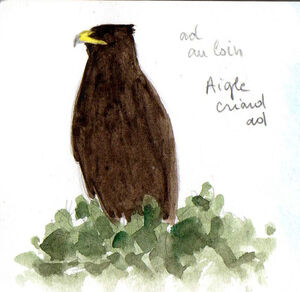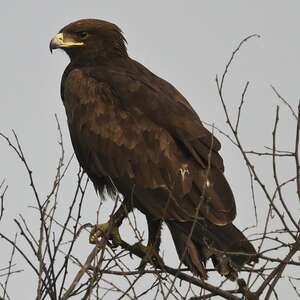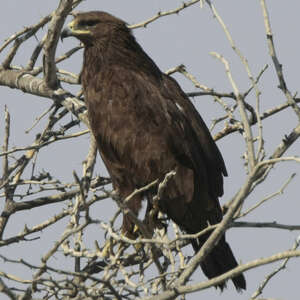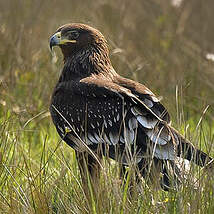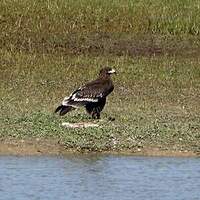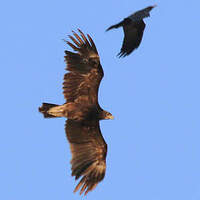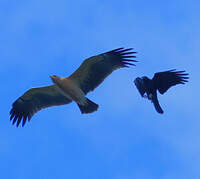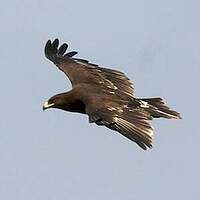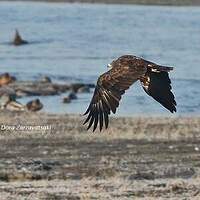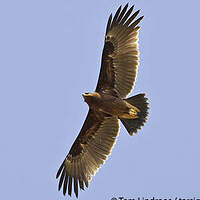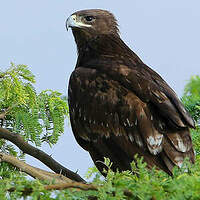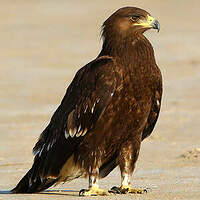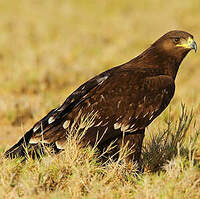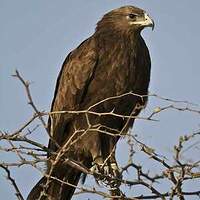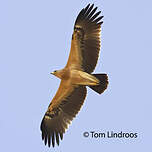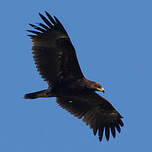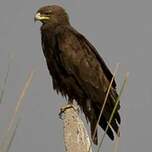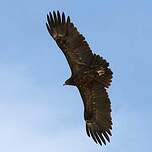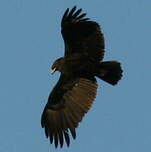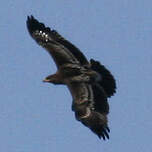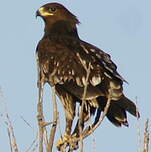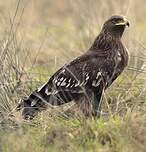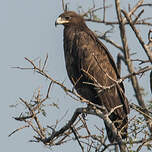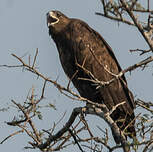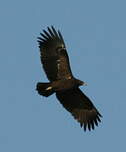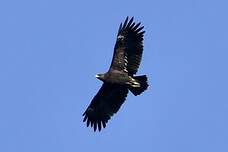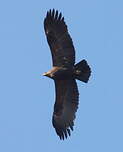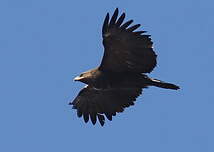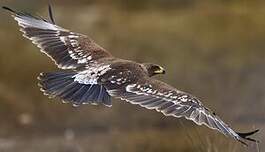Greater Spotted Eagle
Clanga clanga - Aigle criard
Identification
The Greater Spotted Eagle is a medium-sized eagle with broad wings and a short tail. It should be noted right away that it has similarities with its congener, the Lesser Spotted Eagle, with which it was confused until the 19th century. Moreover, it is now proven that it is capable of hybridizing with it, producing birds with an intermediate phenotype, which can complicate identification.
The adult is distinctive, with its dark brown plumage that can appear black at a distance and especially in poor light. Distinctive also is its silhouette in flight. Its broad 7-finger wings make the tail seem shorter than it is. The latter is very rounded at the end, even slightly cuneiform. The coverts are of the same dark brown as the body. In the upper view, the top is uniformly dark brown, with only the uppers-caudal slightly clearer and a bright flash at the level of the palm. On the other hand, in the underside view, the primaries have a glossy gray-brown appearance that makes them appear lighter than the coverts. Finally, the lower belly and the under-coat is light and contrasting.
At rest, the wings barely exceed the tail. The tarsi are closely plumaged and thus appear quite slender. Finally, when the bird can be seen from close enough, the rounded nostrils, not slit, should be noted.
By comparison, the adult Lesser Spotted Eagle is smaller and better proportioned, with wings less wide. The back is more contrasted, with the mantle darker than the coverts, the clear arc of circle at the base of the tail and the bright flash of the palm much more pronounced. From below, the coverts are lighter than the primaries.
The adult Greater Spotted Eagle could also be confused with the adult Steppen Eagle where they coexist.But this last one is bigger, with longer wings and tail, resulting in a substantially different silhouette, but they both present the same dark plumage. From up close one has to observe the plumy tarsus, appearing bulky, as well as the oblique nostrils.
In the Greater Spotted Eagle, there exists a very particular pale morph called fulvescens. This morphotype presents the tint of the body's feather the tint of a creamy russet, in strong contrast to the remiges and rectrices of a dark brown, as so as its counterpart. Such a bird could thus be mistaken for a young Short-toed Eagle, for example.
The juvenile differs from adult through an even darker plumage, black-brown like, featuring clear whitish extremities of certain plumes, major and minor coverts, scapulars, tertial remiges and upper-tail coverts, a plumage pattern that does not have an equivalent among Old World raptors. A young pomarine is darker than adult and can approach the Greater Spotted Eagle's tint in nuance, but the clear extremities of the aforementioned plumes are more narrow hence less visible. The situation is intermediate for the hybrid. In successive moults, the clear spots of the plumage will tend to progressively fade away, until eventually disappearing altogether from the adult.
Subspecific information monotypic species
Foreign names
- Aigle criard,
- Águila moteada,
- águia-malhada,
- Schelladler,
- fekete sas,
- Bastaardarend,
- Aquila anatraia maggiore,
- större skrikörn,
- Storskrikørn,
- orol hrubozobý,
- orel volavý,
- Stor Skrigeørn,
- kiljukotka,
- Groot Gevlekte Arend,
- àguila cridanera,
- Gjallörn,
- orlik grubodzioby,
- vidējais ērglis,
- veliki klinkač,
- Большой подорлик,
- カラフトワシ,
- 乌雕,
- นกอินทรีปีกลาย,
- 花鵰〔大烏鵰〕,
Voice song and cries
Habitat
The Greater Spotted Eagle is a bird of prey for breeding. It enjoys large, wet plains forests where it can hide its nest, but it also hunts in open habitats. Its breeding territory thus includes pure forest blocks interspersed with marshes, meadows, riparian woods, and watercourses or ponds. In the winter, it mainly frequents large coastal and inland wetlands where it can feed on plentiful wildlife. The Camargue is a good example of a wintering site for this species.
Behaviour character trait
The Greater Spotted Eagle is a placid raptor, with restricted predatory capabilities in comparison with its bigger relatives.
It can spend long hours perched high on a commanding tree or edge, watchfully scanning for hunting grounds, awaiting for the right opportunity. It becomes more demonstrative when it returns to its breeding grounds. Just like many other gliding raptors, it can spend lengthy moments in flight, making use of its wide wings, to patrol its huge territory and parade with its mate. That is when it becomes vocal and a breeding is certain to follow.Flight
The Greater Spotted Eagle is a devotee of soaring flight as its morphology inclines, with wide wings and tail particularly well suited to sustaining the weight of the body. The wings are then held along the plan of the body, with the hand slightly drooping. The flapping flight is ample and supple, with rather slow beats.
Dietfeeding habits
The Greater Spotted Eagle primarily feeds on small terrestrial vertebrates. The proportion of birds in its diet is greater than that of the Marsh Harrier.
In the summer, it consumes the majority of small mammals such as voles, followed by birds. It also eats amphibians and reptiles in smaller numbers. During the winter, birds become even more important and the species can successfully tackle larger prey such as Grey Herons or Great Egrets, as has been noted in the Khors of the Arabian Peninsula. This is when its true hunting capabilities can be judged, despite its relatively weak talons. It may occasionally become a scavenger if necessary.Reproduction nesting
The Greater Spotted Eagle needs a large territory of several tens of km² in order to settle. It loves to nest in the heart of large leafy forests, far away from the edges.
The nest, of large size, is built on a tree, usually quite high in the main fork. It sometimes uses an old nest of another bird of prey as a building base. Like many other species, it can build several nests and use them alternately from one year to the next, usually depending on the success or failure that preceded it. The female lays two eggs in April or May on average, which she incubates for 40 to 45 days. The male supplies her with food during this time. Cannibalism usually means that only one young bird takes off from the nest in July or August, at the age of about two months.Geographic range
The Greater Spotted Eagle's breeding range extends to the north of the Eurasian continent at relatively high latitudes, from Poland to China, through Russia. It is a migratory bird. Its wintering range is disconnected and much more southerly, extending from Spain to east China, covering the Mediterranean basin, the Arabian peninsula, Iran, India and Indochina.
Threats - protection
IUCN conservation status
concern
in the Wild
threatened
evaluated
The Greater Spotted Eagle is very threatened in the European Union, where its nesting has become very marginal. It is also in many other developed countries where it suffers from the influence of negative factors such as intensive forestry or drainage of wetlands. It is also very sensitive to human presence in its nesting sites.
On the other hand, in the heart of its range, in more remote spaces, it can still be quite common, but never abundant. It is the strong decline and lack of partners that are at the origin of hybridization with the Pomarine Eagle in the west of the range.
Sources of information
- IOC World Bird List (v14.1), Gill, F and D Donsker (Eds). 2024-04-18.
Other sources of interest
 Specification sheet created on
26/07/2023 by Jean François
Specification sheet created on
26/07/2023 by Jean FrançoisTranslation by AI Oiseaux.net
published: 01-12-2016 - Updated: 29-12-2016
© 1996-2024 Oiseaux.net
- Accipitriformes
- Aegotheliformes
- Anseriformes
- Apodiformes
- Apterygiformes
- Bucerotiformes
- Caprimulgiformes
- Cariamiformes
- Casuariiformes
- Charadriiformes
- Ciconiiformes
- Coliiformes
- Columbiformes
- Coraciiformes
- Cuculiformes
- Eurypygiformes
- Falconiformes
- Galliformes
- Gaviiformes
- Gruiformes
- Leptosomiformes
- Mesitornithiformes
- Musophagiformes
- Nyctibiiformes
- Opisthocomiformes
- Otidiformes
- Passeriformes
- Pelecaniformes
- Phaethontiformes
- Phoenicopteriformes
- Piciformes
- Podargiformes
- Podicipediformes
- Procellariiformes
- Psittaciformes
- Pterocliformes
- Rheiformes
- Sphenisciformes
- Steatornithiformes
- Strigiformes
- Struthioniformes
- Suliformes
- Tinamiformes
- Trogoniformes

